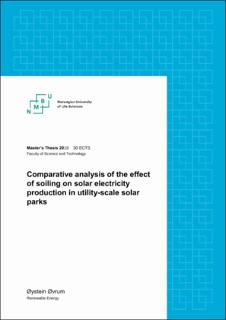| dc.description.abstract | Dust accumulation on solar panels is a significant decreasing factor for the electricity production from utility scale solar power parks. In this master’s thesis, a literature study and an experimental research is conducted to broaden the knowledge of dust characteristics and its optical impacts. The studied literature is structured according to a concept of dust life cycle, which comprises five steps: Generation, transport, deposition, adhesion and removal. For all of the dust life cycle phas-es, the most important natural and anthropogenic factors are presented. This is followed by a discussion of the possible impacts of soiling on the electricity production. The main concern is related to loss of irradiance reaching the panel, which reduces the current of the solar cell. A sec-ondary, indirect effect of soiling is related to reduction in voltage, due to an enhanced cell tem-perature.
The experimental study has shown that for open, barren regions, the dust deposited on the solar panels is strongly correlated with the topsoil in the vicinity of the park. The dust collected from a vegetated area in the middle of the blooming season revealed dissimilar visual and chemical composition between module dust and topsoil.
Furthermore, the transmission loss of sunlight through a dust layer indicated a dependency on three dust parameters. Firstly, the most crucial determinant proved to be particle size distribu-tion, followed by albedo which has a distinct, yet secondary role. Additionally, weak indications have pointed towards an increased transmission loss at high iron oxide content in the dust, but more data is required to confirm this result.
The results from the transmission measurements revealed an α-coefficient for panel dust from arid areas in the range between 0.0203 m2/g and 0.0309 m2/g. This gave a difference of almost 5% in attenuation of the sunlight between the “worst” and the “best” dust types at a typical soil-ing layer of 5 g/m2. Assuming an equal climate, the solar power plant contaminated with the worst dust type would experience either a higher deficit in the electricity production or increased frequency of cleaning the modules. In either case, it will inevitably result in a increased loss in total revenue.
The concluded interrelationship between transmission of sunlight and particle size distribution, albedo and iron oxide content has culminated in a proposed standard procedure for collection and analyzing dust at a potential location prior to establishment of a utility scale power plant. Sufficient dust collection from a panel with low dust density can be achieved with a squeegee and water spray gun. The dust sample can in a next step be measured in situ with a FBRM device to detect the particle size distribution. The albedo can be found by imaging with ImageJ and an XRD device could assess the iron oxide content of the dust samples. These parameters can be fed into a proposed model for assessing the transmission of sunlight as a function of the density of dust. The model can be developed on the basis of data from this thesis and future research. Alongside a thorough assessment of the natural and anthropogenic factors influencing the dust life cycle, transmission estimations can provide decision makers with valuable information before deciding on a future solar power plant project. | en_US |

